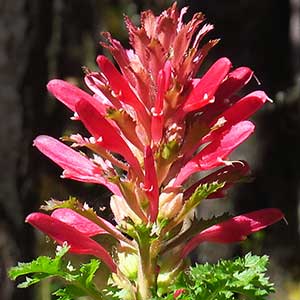Pedicularis densiflora
Pedicularis parryi
Indian warrior, warrior's plume
Parry's lousewort
basal 1–10, blade lanceolate, 30–200 x 20–70 mm, 2(or 3)-pinnatifid, margins of adjacent lobes nonoverlapping or extensively overlapping distally, 1-serrate, surfaces glabrous, hispid, or downy;
cauline 4–20, blade lanceolate, 15–250 x 5–100 mm, 2-pinnatifid, margins of adjacent lobes nonoverlapping or extensively overlapping distally, serrate, surfaces glabrous, hispid, or downy.
basal 4–20, blade elliptic or lanceolate to oblanceolate, 10–70 x 3–15 mm, 1-pinnatifid, margins of adjacent lobes nonoverlapping or slightly overlapping distally, 1- or 2-serrate, surfaces glabrous;
cauline 0–20, blade lanceolate, 10–50 x 2–10 mm, 1-pinnatifid, margins of adjacent lobes nonoverlapping or slightly overlapping distally, serrate, surfaces glabrous or tomentose.
simple, 1–5, exceeding basal leaves, each 10–50-flowered;
bracts lanceolate to trullate, 10–35 x 3–5 mm, undivided or 1-pinnatifid, proximal margins entire, distal 1- or 2-serrate, surfaces glabrous.
simple, 1–10, exceeding basal leaves, each 5–50-flowered;
bracts subulate to trullate, 10–25 x 8–10 mm, undivided or +/- lobed, proximal margins entire, distal serrate or crenate, surfaces glabrous or tomentose.
2–4 mm.
2–3 mm.
calyx 9–18 mm, downy to tomentose, lobes 5, triangular, 3–4 mm, apex entire, ciliate;
corolla 23–43 mm, tube dark red, purple, or orange-yellow, rarely white, 8–18 mm;
galea dark red, purple, or orange-yellow, rarely white, 15–25 mm, beakless, margins entire medially and distally, apex straight;
abaxial lip dark red, purple, or orange-yellow, rarely white, 8–15 mm.
calyx 6–10 mm, glabrous or tomentose, lobes 5, triangular to deltate, 1–3 mm, apex entire, glabrous;
corolla 14–22 mm, tube white, yellowish, or light purple to purple, 7–15 mm;
galea white, yellowish, or light purple to purple, 7–10 mm, beaked, beak straight, 5–8 mm, margins entire medially and distally, apex extending beyond abaxial lip;
abaxial lip white, yellowish, or light purple to purple, 4–9 mm.
= 16.
= 16.
Pedicularis densiflora
Pedicularis parryi
Scarlet corollas with an undomed, toothless galea and two- or three-pinnatifid leaves are diagnostic of Pedicularis densiflora. This species occurs in forested subalpine regions of southern Oregon, western slopes of the Sierra Nevada, and the Coast Ranges of California south to Baja California. Herbarium records indicate northern populations of P. densiflora occur at higher elevations than do more southern populations.
(Discussion copyrighted by Flora of North America; reprinted with permission.)
Subspecies 3 (3 in the flora).
Pedicularis parryi is characterized by a domed galea with a conical beak and light green calyces and floral bracts with dark purple stripes. The beaked galea extends well beyond the expanded lobes of the abaxial lip.
Pedicularis parryi is an alpine complex. Corolla color, number of cauline leaves, and bract margin variation are important features differentiating infraspecific taxa within P. parryi (G. D. Carr 1971, from which the following key is adapted).
(Discussion copyrighted by Flora of North America; reprinted with permission.)
1. Corolla tubes +/- purple; calyces tomentose. | subsp. purpurea |
1. Corolla tubes white or yellowish; calyces glabrous. | → 2 |
2. Cauline leaves (0 or)1–6; bract margins entire or +/- crenate. | subsp. parryi |
2. Cauline leaves 5–20; bract margins +/- serrate. | subsp. mogollonica |


